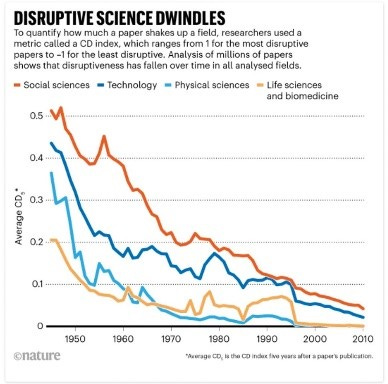“Constructive Skepticism” Volume 2 – Handbook #IV: The Template for Reading Research Papers – Understanding What Readers Do
For new readers: Please read the “Pinned Post” at the top of this Substack’s Home Page, and titled Why Use Public Peer-Review to Write a Book? - “See for Yourself”.
For returning readers & subscribers: This first post in a series of three posts connects new dots with last week’s post as part of a process to understand its readers: What do readers do, say, and read? This post focuses on what readers do.
The Iceberg of Bad Papers
Last week’s post started with this observation: In the first half of 2024, we saw the tip of an iceberg break through the surface of mainstream consciousness. The Wall Street Journal published an article that highlighted the existential need for reading research from the perspective of the “Constructive Skepticism” curriculum.
The title of the article, published on 5/14/24, says it all: Flood of Fake Science Forces Multiple Journal Closures, Wiley to shutter 19 more journals, some tainted by fraud.
[See link: https://www.wsj.com/science/academic-studies-research-paper-mills-journals-publishing-f5a3d4bc ]
- The problem looks institutional: As the WSJ points out in this recent article, an iceberg of bad papers has grown in the middle of a “$30 billion academic publishing industry”.
- The scale of the iceberg of bad papers crowds out the good: The title of John Iaonnidis’ 2005 paper published in PLoS Medicine says it all: “Why Most Published Research Findings Are Flase”, and to paraphrase Nigel Tufnel’s demonstration in “This is Spinal Tap” (1984), Artificial Intelligence (AI) and Large Language Models (LLMs) “turned the dial to 11”.
The Iceberg of Bad Papers that Sank Meaningful Innovations
This week’s post continues by showing one of the casualties from this iceberg of bad papers: Again, the title of an article, published on January 4, 2023 in Nature, says it all: “Disruptive” science has declined – and no one knows why, the proportion of publications that send a field in a new direction has plummeted over the past half-century.
[See link: https://www.nature.com/articles/d41586-022-04577-5 ]
The innovation value of science, thus the competitive advantage that it gives to industry, has declined, and the most precipitous decline took place in the Social Sciences, the home of Financial Economics, Investment Management, and Retirement Planning, as you can see from the chart titled: “Disruptive Science Dwindles” in the article, and reproduced below:
The iceberg of bad papers sank meaningful innovations, along with many businesses that relied on them for competitive advantage. How long will presenting “same-old” with pretty pictures keep clients in the fold? Has the false confidence that comes from buy-now-pay-later institutional convenience crowded out the competence that comes from the upfront cost of individual earned experience?
Where Can You Find Meaningful Innovation?
The short answer: “See for Yourself”.
Innovation starts with individuals, and innovative institutions empower innovative individuals. On the positive side, connecting the dots between the WSJ’s and Nature’s articles implies the existence of a matching trend of increasing marginal value from asking good questions, and getting good answers because there are fewer and fewer of them, over time, and especially at this time.
CTRI’s “Constructive Skepticism” curriculum in general, and the Template for Reading Research Papers in particular focus on asking good questions in order to get good answers.
https://www.amazon.com/CTRIs-Template-Reading-Research-Papers/dp/B0D2WBP7L1?ref_=ast_author_mpb
Readers that “See for Yourself”, with the help of the Template for Reading Research Papers, and other means are the place where you can find meaningful innovation.
What Value Do You Place on Finding Meaningful Innovation?
As a means to understand its readers, and to understand where they think the “puck” is moving, this series of three posts reaches out to readers in order to develop good questions about what they do, what they say, and what they read.
The most direct answers to questions come from looking at what people do, as contrasted with what they say. This section presents two questions about doing, so that we can edit them together before we use them up in surveys on Substack, and LinkedIn.
Sample Question about Doing #1:
What are you willing to pay as a measure of your eagerness to achieve a supply of good questions, so that you can create your own “See for Yourself” answers:
Nothing?
A free individual subscription on Substack?
$15 for a print copy of the Template for Reading Research Papers on Amazon?
$50 per year for a paying individual subscription on Substack?
$100 per year for a Charter individual subscription on Substack?
Join CTRI as an associate institutional member?
Join CTRI as a regular institutional member?
Sponsor an internal, institutional educational program based on the “Constructive Skepticism” curriculum?
Sponsor a conference program based on the “Constructive Skepticism” curriculum?
Sponsor the publication of the Workbooks, Handbooks, and Notebooks of the “Constructive Skepticism” curriculum on Amazon?
Other (please specify): ________
Sample Question about Doing #2:
What are you willing to do to support this supply of good questions, and answers:
What would you change or edit in these sample questions?
What other questions would you recommend for inclusion in these questionnaires?
What tools and apps would you recommend that we use to deliver such questions and questionnaires on Substack and/or on LinkedIn?
Other (please specify): ________
Looking forward to seeing, and reading about what you do.
“CTRI by Francois Gadenne” writes a series of Workbooks, Handbooks & Notebooks about “Constructive Skepticism” with a process of public peer review on Substack. These books connect the dots of life-enhancing practices for the next generation, free of controlling algorithms, based on the lifetime experience of a retirement age entrepreneur, and continuously updated with insights from reading Wealth, Health, & Statistics (i.e. AI/ML/LLM) research papers on behalf of large companies as the co-founder of CTRI.


